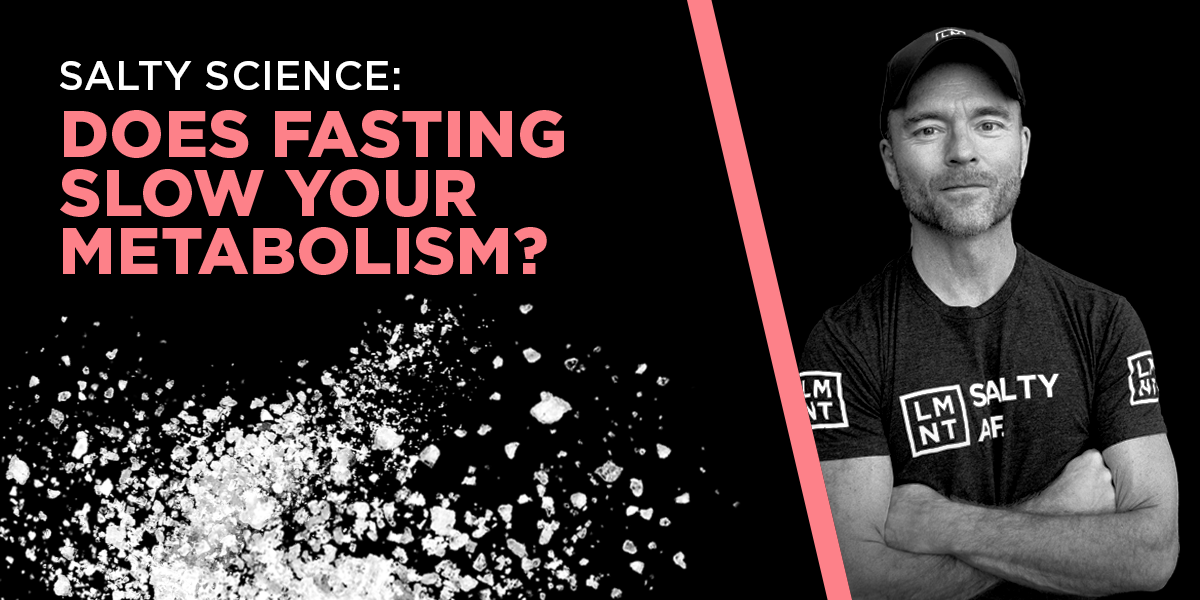There’s a meme floating around that fasting slows your metabolism. The claim is that fasting (even intermittent fasting) makes you cold, sluggish, and prone to weight gain following a refeed.
I’m not surprised this meme has spread. It makes sense that depriving your body of nutrients would have a metabolic-shutdown effect. It’s a survival mechanism.
But the meme is only half true. Sure, if you chronically restrict calories—or starve for many days on end—your metabolic rate will tank. You’ll feel slothful and unwilling to exercise. Still, you’ll probably lose weight.
Yet when you eat normally again, your metabolism won’t rev back up. Which means the lost weight will come back. This is why calorie restriction (CR) generally doesn’t work for sustainable weight loss.
But intermittent fasting—or periodically limiting calories—is a different beast altogether. IF, in fact, has radically different effects on human metabolism than long-term calorie restriction. Unlike CR, IF doesn’t lower your metabolic rate. This means that fat lost on IF is more likely to stay lost.
To understand why this is true, we need to dive into the science of metabolism, calorie restriction, and body weight regulation. And I promise that—even though I’m a former research biochemist—I’ll keep the jargon to a minimum.
I don’t want your eyes to glaze over. I want you to be able to explain this stuff to a skeptical friend.
First, I need to cover some basics of metabolism and body weight. Sound good? Cool.
What Is Metabolic Rate?
Your metabolic rate—also called basal metabolic rate (BMR) or resting metabolic rate (RMR)—is the amount of energy needed to power basic bodily functions. These functions include heartbeat, breathing, brainpower, and all other processes that keep you alive.
Depending on how active you are, about 60% to 70% of daily energy expenditure goes towards RMR and the rest towards physical activity. Spontaneous physical activity (which includes fidgeting and changing position), is a decent chunk of the total, about 10%. Fidgety people burn more calories.
Metabolic rate is closely tied to weight regulation. The lower your metabolic rate, the fewer calories you burn, the more weight you gain when you eat X number of calories.
This is overly simplistic, of course. When it comes to gaining or losing weight, a fat calorie has different effects than a carbohydrate calorie. And you have to account for leptin, insulin, and a bunch of other hormones.
That’s for another post. For now, let’s accept this basic principle: If you eat more calories than your metabolism uses, you will generally gain weight.
The opposite is also true. If you eat less than your metabolism uses, you will generally lose weight.
Put even more simply: If the energy in doesn’t equal energy out, your weight will change. This concept is called energy balance.
Many “experts” have seized upon this principle—ignoring all other variables—to design their weight loss programs. These programs are typically calorie restriction diets, and they work for weight loss.
But the weight comes roaring back after the diet ends. Why? Keep reading.
Calorie Restriction Slows Metabolism
Calorie restriction refers to a chronically insufficient diet—usually 15% to 50% fewer calories per day than your metabolism demands. Calorie restriction is a state of negative energy balance, and it usually results in weight loss.
If you’ve ever watched The Biggest Loser, you’ve seen this effect in action. Contestants are put on calorie-restricted diets, they lose weight, and everyone celebrates.
The show doesn’t mention, however, that contestants invariably regain most of the weight they lost. Their metabolism adapts to the low-calorie diet. It’s their bodies saying: Hey, if we’re gonna do this CR thing day after day, I’m gonna switch over to low power mode.
And once low power mode gets activated, it stays activated. One study on 16 participants from The Biggest Loser found that their metabolisms were still depressed six years after the show!
Part of this makes sense. If you lose weight, your RMR should drop because now you’re a smaller person. But on calorie restriction, RMR drops more than predicted by weight loss alone.
In one controlled study, researchers put 48 overweight people on either calorie-restricted or non-CR weight maintenance diets for six months. The results were interesting. Not only did the CR groups have reduced RMR, but they also did less physical activity than the control group.
The low power mode analogy really fits here. Starvation is well known to induce apathy and sluggishness in humans.
To sum up the problems with CR diets: They restrict calories, metabolism slows, and when normal portions resume, the now sluggish metabolism can’t burn that extra energy. One group of researchers puts it another way:
“If food intake returns to pre‐weight loss levels,” they write, “weight regain is imminent unless [energy expenditure] is increased through exercise.”
And remember: A slow metabolism hinders exercise motivation. Fortunately, there’s an alternative. Let’s look at how intermittent fasting affects your metabolism now.
Intermittent Fasting and Metabolism
Fasting is often equated with starvation. Picture a shriveled man, ribs protruding, marooned on a desert island for months without a solid meal.
But that would be long-term caloric restriction, not intermittent fasting—which I’ll loosely define as any fast between 12 and 36 hours.
Calorie restriction slows your metabolism. But short-term fasting with regular refeeds has the opposite effect.
Think about it this way. If you were a hunter-gatherer roaming the plains 40,000 years ago, would you want your body shutting down after a fruitless hunt? Of course not. You’d want to be extra alert so you could bring down a prehistoric mammal on the next hunt.
That’s exactly what happens during an intermittent fast. Fueled by the burning of fat, your metabolic rate is maintained or increased by temporary fasting. Let’s look at two studies that illustrate this point.
Study #1: Alternate-day fasting
In this small study, researchers fasted 16 people every other day for 22 days (36 hour fasts). The participants lost 2.5% of their bodyweight, and showed increased fat oxidation on fasting days. Even accounting for the weight loss, their resting metabolism stayed the same.
Study #2: Up to four days of fasting
Researchers took lean subjects and fasted them for four days. They found that—up to and including the fourth day—the resting energy expenditure (metabolic rate) of the subjects was higher than baseline.
Driving this effect was norepinephrine, a naturally-produced hormone that increases heart rate, boosts mood, and increases RMR. Fasting, it was found, increased norepinephrine levels by over 100%.
Why does fasting boost norepinephrine? It’s a geeky question, but bear with me for a second if you want to learn something new.
One theory is that low blood sugar during a fast signals the adrenal medulla (in the kidneys) to unleash a bunch of norepinephrine. Norepinephrine’s job is to prevent dangerous hypoglycemia, and it tells the liver to make more glucose. This is called gluconeogenesis.
Gluconeogenesis requires a lot of energy, so it raises RMR. Cool factoid.
Intermittent Fasting for Weight Loss
If intermittent fasting decreased your metabolism, it wouldn’t promote sustainable weight loss. It would be like calorie restriction.
But this isn’t the case. When you fast, fat oxidation (fat burning) increases, bodyweight decreases, and resting metabolic rate increases or stays the same.
Consider the following published examples on IF for weight loss:
- A 2018 review of the relevant literature found intermittent fasting “to be efficient in reducing weight, irrespective of the body mass index.”
- Eight weeks of 16/8 intermittent fasting significantly decreased fat mass in 34 resistance-trained men. Resting metabolic rate stayed the same.
- Young overweight women lost as much weight on 5:2 intermittent fasting as they did on daily calorie restriction. Same weight lost, but probably without the metabolic slowdown.
- Compared to three meals per day, one meal per day (OMAD) caused more fat loss and improved markers of heart disease risk in normal-weight people.
The last study makes an important point: Skipping meals can be good for your health.
Is Skipping Meals Healthy?
Dogma holds that you should eat three square meals a day. For some people, three squares probably works best.
For instance, it’s been shown that female breakfast skippers have higher stress hormones and blood pressure than female breakfast eaters. Also, eating a high protein breakfast helps set you up for higher melatonin (sleep hormone) levels at night. So there’s that. But other research suggests that eating breakfast isn’t such a great weight loss strategy.
Ultimately, the wisdom of meal skipping depends on the person. An underweight person shouldn’t be fasting, but their overweight friend may do well to compress their feeding window as a means to reducing daily calorie intake. If you’re going to try intermittent fasting, start slow. Go for 12 hours without food, then 13, then 14. Work your way up as comfort and schedule permit.
Finally, unless the specific fasting protocol calls for it, try not to restrict calories. This will keep your metabolism humming along, so when you eat again, that food will go right to energy.
Tips For Not Gaining Weight After A Fast
Post-fasting, many folks report a weight rebound. This is totally normal! However, there are ways you can minimize this effect, which I covered in my article 7 ways to minimize weight gain after a fast. Check it out to learn more!

